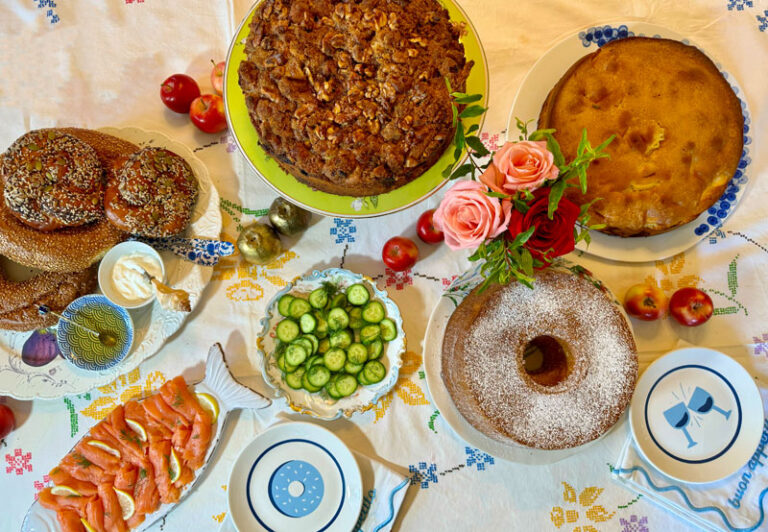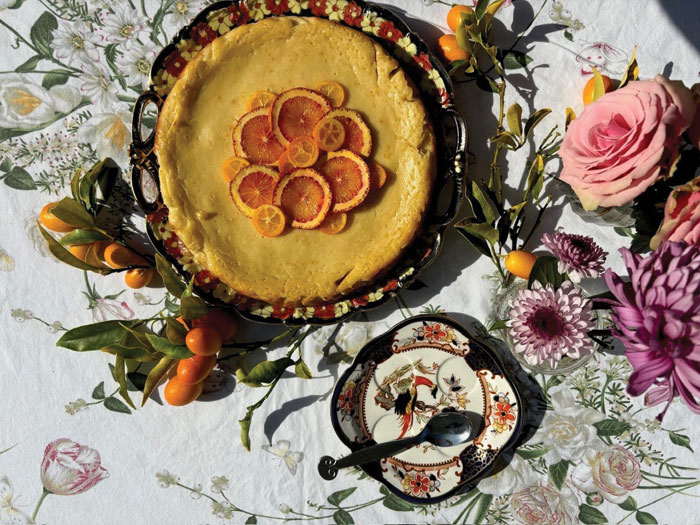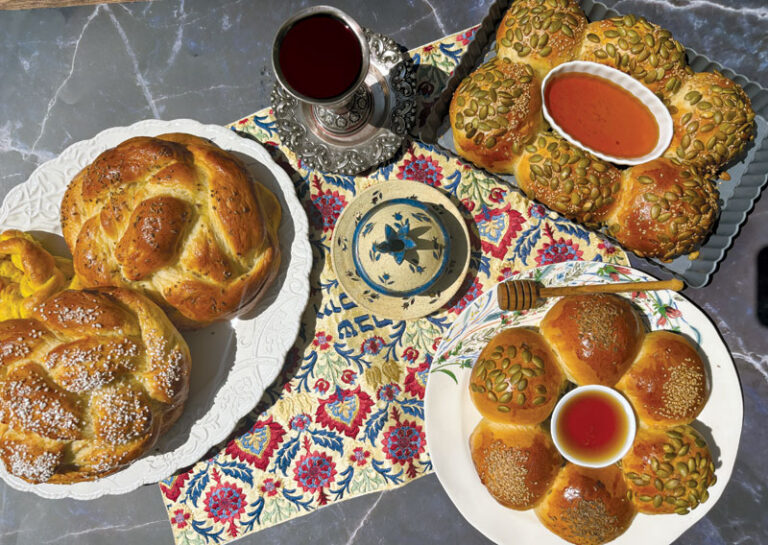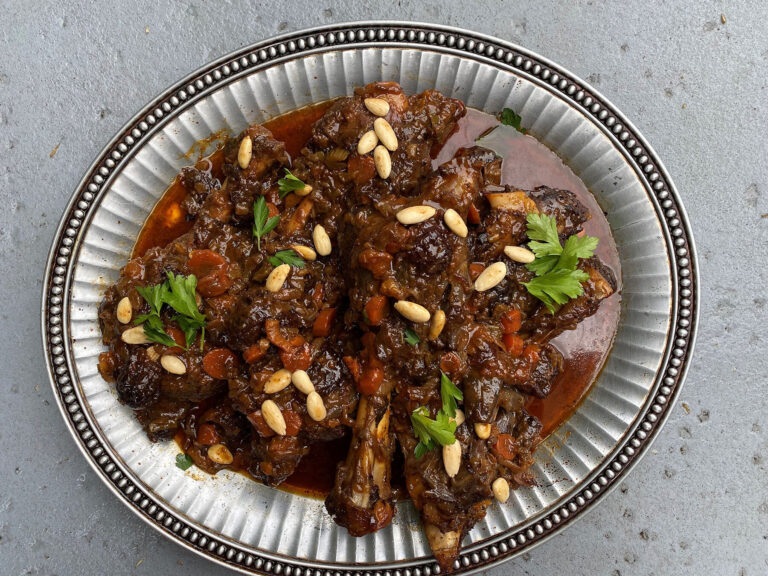Do You Believe in Magic: Orange Semolina Cake

It was a magical night by the Aegean Sea in Bodrum. The waves rippled softly, reflecting the light from our hotel. We were mesmerized by the shimmering blue and the sparkling white and silver of the water. The water was so magical that I almost expected to see a mermaid emerge.
Of course, there was no mermaid, but Neil and I were served the most heavenly orange cake.
This summer Neil and I took a short flight from Istanbul to Bodrum, a city that hugs the southwestern coast of Turkey. Founded by Dorian Greeks, the city later fell under Persian rule. One such ruler was Mausolos and when he died in 353 BCE, his wife Artemisia built him a tomb called the Mausoleum. This structure was known as one of the seven wonders of the ancient world (and now you know how the word mausoleum entered the English language). The area was conquered by Alexander the Great and ruled by Hellenists. Then it was ruled by the Romans.
The Knights Hospitaller arrived in 1402 and used the remains of the Mausoleum to build Bodrum Castle, a beautiful Gothic structure that still dominates the skyline.
In 1522, when Suleiman the Magnificent conquered the nearby island of Rhodes, the Knights left Bodrum for Europe and the area fell under Ottoman rule.
Once upon a time, the people of Bodrum earned a living from fishing and sponge diving. More recently, Europeans discovered the charm of this sunny, idyllic spot and tourism has become the main industry. The life there still beats to a simple rhythm and the locals are so warm and kind. There is a farmers market overflowing with the fresh produce grown in the local hills and low mountains. I have honestly never tasted such incredibly sweet and juicy figs. There is an abundance of dried fruits and nuts, aromatic spices and fresh herbs like oregano and za’atar. Piles of fresh fish glisten, recently caught in the fishermen’s nets. And the Greek influence is evident in the tons of fresh feta and other homemade cheeses.
Every afternoon, Neil and I indulged in a Turkish coffee and syrupy, honeyed baklava, in lots of different shapes and varied fillings. It was wonderful.
But that cake! I took one bite and had the most intense flavor flashback. I was instantly transported to the cakes of my childhood, which were always flavored with orange zest or lemon zest or orange blossom water.
Neil and I took bite after blissful bite. And then we asked the waiter “What is this cake?”
He replied “The chef’s family recipe. It’s a Greek recipe because we are so close to Greece.”
“Wait!” I begged. “Please tell me more.“
He went to the kitchen to ask the chef about the ingredients. He told me that the cake was made with semolina and syrup and lots of fresh oranges.
—Rachel
Did you know that oranges, in all their infinitely sweet, juicy, bright, citrusy wonder, were engineered in ancient China by crossing mandarin with pomelo?
From there, orange varieties spread into Myanmar, Northern India, Persia, the Middle East and North Africa.
The Moors brought oranges to Spain and Portugal. But in the 15th and 16th centuries Portuguese Jewish merchants traveled throughout the Mediterranean, selling citron (etrogim) to their Jewish brethren and sweet oranges to the non-Jewish populations of Italy, France and later Germany.
In Arabic, oranges are called burtaqal, denoting this connection to Portugal.
In most other languages, orange the color and orange the fruit are interchangeable. However, in Hebrew the word for the color orange is katom and the word for the fruit is tapuz, an acronym of tapuchei zahav(apples of gold).
With their deliciously refreshing flavor and storied history, it is no wonder that oranges play a huge part in the flavor profile of Middle Eastern and Sephardic cooking.
With their deliciously refreshing flavor and storied history, it is no wonder that oranges play a huge part in the flavor profile of Middle Eastern and Sephardic cooking.
—Sharon
When I came home, I was obsessed with that cake. I worked hard to replicate the recipe. My first cake wasn’t moist enough because I wasn’t generous enough with the syrup.
But this recipe is magical and it’s just in time for peak orange season.
We hope you bake this special cake soon.
—Rachel
Orange Semolina Cake
1 cup fine semolina flour
1 cup all-purpose flour
2 teaspoons baking powder
1/8 teaspoon of salt
½ cup orange juice
1 teaspoon vanilla essence
2 sticks softened butter or vegan butter
1 ¼ cup sugar
3 large eggs, at room temperature
For the syrup
3/4 cup orange juice
Zest of 2 oranges, finely grated
3/4 cup sugar
2 tablespoons orange blossom water
For decoration
1 cup Greek yogurt or coconut milk yogurt
(non-dairy option)
¼ cup sugar
Candied oranges or toasted pistachios
- Preheat the oven to 350°F.
- Line the bottom of an 8 inch springform pan with parchment paper, then grease the sides with oil spray.
- In a medium bowl, place the semolina, flour, baking powder and salt and mix well.
- In a small bowl, combine the orange juice and vanilla, then set aside.
- In the bowl of a stand mixer, beat the butter and sugar until very creamy and pale white.
- On the low setting, add half the flour and half the orange juice, mix until just combined.
- Add the remaining flour and orange juice. Do not over beat.
- Pour the batter into prepared pan and bake for 45 minutes or until a toothpick comes out clean from the center of the cake.
- Place on a cooling rack.
- Prepare the syrup by combining the orange juice, orange zest, sugar and orange blossom water in a small sauce pan.
- Bring to a boil over medium heat. Stir well, then lower heat and simmer until the syrup begins to thicken.
- Remove from heat and allow syrup to cool.
- Once the cake has cooled, poke holes in the top of the cake with a toothpick.
- Pour syrup over the cake.
Wrap cake tightly with plastic wrap. - Just before serving, beat the yogurt with the sugar and pour over the cake.
- Decorate with pistachios, or fresh candied orange slices.
Candied orange slices
2 oranges, washed and dried
1/4 cup sugar
Fresh rosemary, optional
- Slice oranges into thin rounds and remove any pits.
- Place in a pan with ¼ cup of sugar and rosemary.
- Simmer until sugar becomes syrupy and orange slices have released their juice.
- Set aside to cool.
Rachel Sheff and Sharon Gomperts have been friends since high school. They love cooking and sharing recipes. They have collaborated on Sephardic Educational Center projects and community cooking classes. Follow them on Instagram @sephardicspicegirls and on Facebook at Sephardic Spice SEC Food.







